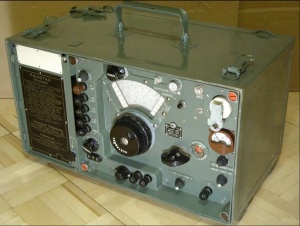OIRT
From HFUnderground
| (13 intermediate revisions not shown) | |||
| Line 1: | Line 1: | ||
| - | ''In | + | ''In America, you listen to radio.'' |
| - | + | ''...In Soviet Russia, radio listens to you! GO TO CORRECTIVE LABOR CAMP!'' | |
| - | '' | + | [[File:Soviet_Radio.jpg|300px|thumb|left|No really, it ''does'']] |
| - | OIRT | + | The name OIRT comes from the radio and television organization '''Organization Internationale de Radiodiffusion et de Télévision''' (OIRT), which was based in Prague . It was considered the “socialist counterpart” to the Western European Broadcasting Union (EBU). The OIRT also had a television standard that deviated from the CCIR 601 for over the air television and [[FM|FM radio]] broadcasting because...reasons. In many instances, television broadcasting channel frequencies used in the Soviet bloc / USSR did not match those used elsewhere in Europe. Analog TV broadcast channels were (or are?) unless Russia is also now digital...also different. |
| - | + | OIRT [[FM]] broadcast band, 65.8 MHz to 74.0 MHz. Some sources show it as 65.9 MHz - 74.0 MHz...or 65-74 MHz. 10 kHz offset channels. Lower frequency means longer range but much higher susceptibility to sporadic-E or other skip propagation. 50-75 kHz wide [[FM]] WFM W-FM. Portable transistor radios sold in Russia, the USSR and other Warsaw Pact / Eastern Bloc / Eastern European states included 65-74 MHz FM coverage and 540-1600 kHz AM coverage. Dual band OIRT FM and western CCIR FM band portable radios as well as receivers for home stereo systems have also been marketed for consumers in countries where both bands are used for FM broadcasting. | |
| - | Russia and former Soviet republics, Baltic states, Eastern Europe. '''Slowly''' being phased out in favor of the 88-108 MHz (87.5 MHz - 107.9 MHz, 87.9 MHz - 108 MHz) FM band. It almost overlaps with the oddball Japanese FM broadcast band 76-95 MHz (previously 76-90 MHz) and overlaps with the bottom edge of the new (2021) extended FM band 72.1 MHz to 108 MHz eFM Brazil expanded FM broadcast band. | + | Operates in the 66-88 MHz '''VHF mid band''' region (this is sometimes called "VHF low" or VHFL in many parts of Europe) and can cause major interference to the [[Amateur_radio#Amateur_Radio_Bands_VHF_UHF_and_up|70 MHz]] amateur band / 4 meter band / 4m band and/or land [[Business_Radio#VHF_Mid_Band_72-76_MHz|mobile]] services, fixed link telemetry and [[Remote_Control#72_MHz_RC_Frequencies|data]] link systems operating in the 66-88 MHz band. This includes the license-free [[69 MHz VHF CB]] in Sweden, the [[RHA68]] service in Finland the other services such as the [[BMIS]] Wireless Local Information Service in Czechia / Czech Republic. |
| + | |||
| + | Russia and former Soviet republics, Baltic states, Eastern Europe. '''Slowly''' being phased out in favor of the 88-108 MHz (87.5 MHz - 107.9 MHz, 87.9 MHz - 108 MHz) FM band. It almost overlaps with the oddball Japanese FM broadcast band 76-95 MHz (previously 76-90 MHz) and overlaps with the bottom edge of the new (2021) extended FM band (or eFM) 72.1 MHz to 108 MHz eFM Brazil expanded FM broadcast band. | ||
The OIRT FM broadcast band is still used in Russia and other countries for FM broadcasting (in addition to the now-standardized "Western" FM band). Many stations on the OIRT frequencies simulcast on the standard 88-108 MHz FM band as well. | The OIRT FM broadcast band is still used in Russia and other countries for FM broadcasting (in addition to the now-standardized "Western" FM band). Many stations on the OIRT frequencies simulcast on the standard 88-108 MHz FM band as well. | ||
| + | |||
| + | |||
| + | [[File:R311.jpg|300px|thumb|left|R-311 Soviet era military HF receiver]] | ||
[[Category: VHF/UHF Radio Services]] | [[Category: VHF/UHF Radio Services]] | ||
| + | [[Category: Broadcasting]] | ||
Latest revision as of 18:17, 4 November 2025
In America, you listen to radio.
...In Soviet Russia, radio listens to you! GO TO CORRECTIVE LABOR CAMP!
The name OIRT comes from the radio and television organization Organization Internationale de Radiodiffusion et de Télévision (OIRT), which was based in Prague . It was considered the “socialist counterpart” to the Western European Broadcasting Union (EBU). The OIRT also had a television standard that deviated from the CCIR 601 for over the air television and FM radio broadcasting because...reasons. In many instances, television broadcasting channel frequencies used in the Soviet bloc / USSR did not match those used elsewhere in Europe. Analog TV broadcast channels were (or are?) unless Russia is also now digital...also different.
OIRT FM broadcast band, 65.8 MHz to 74.0 MHz. Some sources show it as 65.9 MHz - 74.0 MHz...or 65-74 MHz. 10 kHz offset channels. Lower frequency means longer range but much higher susceptibility to sporadic-E or other skip propagation. 50-75 kHz wide FM WFM W-FM. Portable transistor radios sold in Russia, the USSR and other Warsaw Pact / Eastern Bloc / Eastern European states included 65-74 MHz FM coverage and 540-1600 kHz AM coverage. Dual band OIRT FM and western CCIR FM band portable radios as well as receivers for home stereo systems have also been marketed for consumers in countries where both bands are used for FM broadcasting.
Operates in the 66-88 MHz VHF mid band region (this is sometimes called "VHF low" or VHFL in many parts of Europe) and can cause major interference to the 70 MHz amateur band / 4 meter band / 4m band and/or land mobile services, fixed link telemetry and data link systems operating in the 66-88 MHz band. This includes the license-free 69 MHz VHF CB in Sweden, the RHA68 service in Finland the other services such as the BMIS Wireless Local Information Service in Czechia / Czech Republic.
Russia and former Soviet republics, Baltic states, Eastern Europe. Slowly being phased out in favor of the 88-108 MHz (87.5 MHz - 107.9 MHz, 87.9 MHz - 108 MHz) FM band. It almost overlaps with the oddball Japanese FM broadcast band 76-95 MHz (previously 76-90 MHz) and overlaps with the bottom edge of the new (2021) extended FM band (or eFM) 72.1 MHz to 108 MHz eFM Brazil expanded FM broadcast band.
The OIRT FM broadcast band is still used in Russia and other countries for FM broadcasting (in addition to the now-standardized "Western" FM band). Many stations on the OIRT frequencies simulcast on the standard 88-108 MHz FM band as well.
This site is a participant in the Amazon Services LLC Associates Program, an affiliate advertising program designed to provide a means for sites to earn advertising fees by advertising and linking to Amazon.com. Some links may be affiliate links. We may get paid if you buy something or take an action after clicking one of these.

